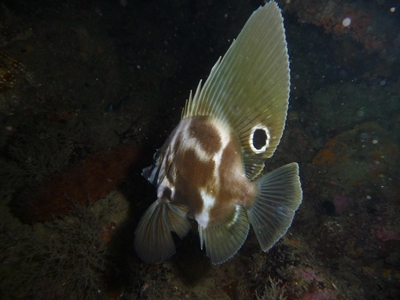General Description
Body deep, strongly compressed, dorsal profile steeply concave; dorsal fin continuous, soft dorsal fin-base much longer than spinous dorsal-fin base, fin-tips often reaching beyond tail. Pelvic and pectoral fins large, pelvic-fin base in front of pectoral fin base. Pale greenish-brown, with a prominent black ocellus on rear of dorsal fin, sides of body darker behind pectoral fin base, a dark marking running from the front of the head below the eyes almost to the corner of the mouth, pelvic fins dark. May be confused with the widespread Blackspot Boarfish, Zanclistius elevates, which has a dark blotch on the rear of the dorsal fin rather than an ocellus and pelvic fin bases inserted behind the pectoral fin bases. To 34 cm.
Biology
This boarfish is sometimes taken as incidental bycatch in commercial trawls.
Habitat
Temperate waters, in depths of 5-80 m.
Reefs
Distribution guide
Southern Australia, including western and central Victoria.
Species Group
Depth
Shallow (1-30 m)
Deep ( > 30 m)
Water Column
Max Size
34 cm
Commercial Species
Yes
Global Dispersal
Native to Australia
Conservation Status
- DSE Advisory List : Not listed
- EPBC Act 1999 : Not listed
- IUCN Red List : Not listed






